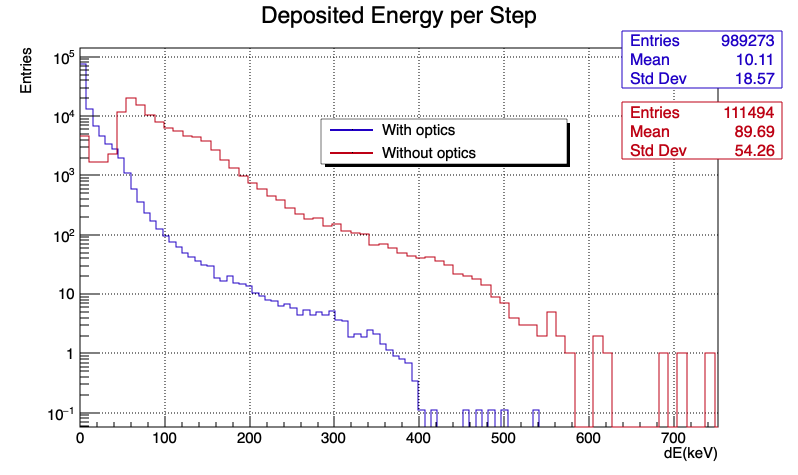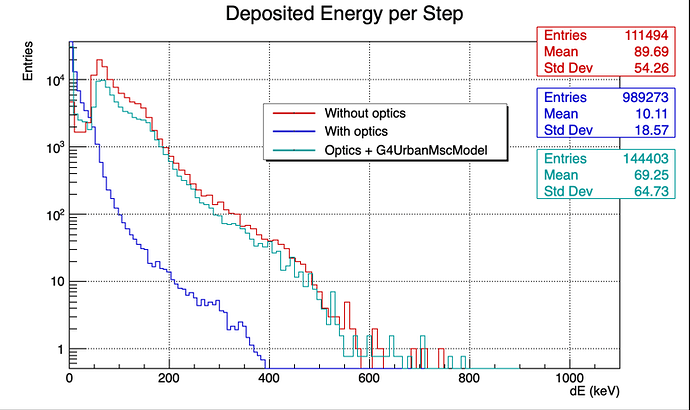Please fill out the following information to help in answering your question, and also see tips for posting code snippets. If you don’t provide this information it will take more time to help with your problem!
_Geant4 Version:_11.2.2
_Operating System:_macOS Sonoma 14.6
_Compiler/Version:_gcc 15.0.0
_CMake Version:_3.29.4
Dear experts,
I have been conducting some simulations of 1MeV electrons in a liquid scintillator (LAB) using Geant4 v11.2.2 and found some discrepancies when adding or not the optical processes while using the EmLivermore physics list.
I am only using the EmLivermore physics list to generate the electromagnetic processes as well as G4OpticalPhysics to generate the optical processes (Scintillation and Cerenkov). However, during the energy loss steps, the processes seems to change drastically when one add or not the optical processes.
Here is a few distributions that highlight the issue I am facing (10 000 electrons of 1 MeV).
I also noticed that most eIoni processes disappeared from the list of processes when the optics is added.
Most processes are now msc when we used to have only 1 msc without the optics.
I observed this feature using LIV, and EMZ (option 4) EM physics lists but default (option 0) and EMY (option 3) EM physics lists do not have this type of issues.
I was wondering if there were some potential conflict between, msc models and optical photon generation
You can see below an output of Geant4 for one event
No optics:
- G4Track Information: Particle = e-, Track ID = 1, Parent ID = 0
Step# X(mm) Y(mm) Z(mm) KinE(MeV) dE(MeV) StepLeng TrackLeng NextVolume ProcName
0 0 0 0 0.612 0 0 0 pTarget initStep
1 0.000149 -0.000252 -0.000725 0.612 7.87e-05 0.000782 0.000782 pTarget msc
2 0.119 -0.206 -0.586 0.499 0.113 0.701 0.701 pTarget eIoni
3 0.199 -0.426 -1.03 0.369 0.129 0.563 1.26 pTarget eIoni
4 0.117 -0.343 -1.37 0.27 0.099 0.415 1.68 pTarget eIoni
5 0.32 -0.434 -1.51 0.206 0.0643 0.312 1.99 pTarget eIoni
6 0.508 -0.467 -1.45 0.153 0.0534 0.25 2.24 pTarget eIoni
7 0.519 -0.343 -1.37 0.0968 0.0557 0.199 2.44 pTarget eIoni
8 0.539 -0.31 -1.3 0.0158 0.081 0.137 2.58 pTarget eIoni
9 0.54 -0.311 -1.3 0 0.0158 0.00604 2.58 pTarget eIoni
With optics:
- G4Track Information: Particle = e-, Track ID = 1, Parent ID = 0
Step# X(mm) Y(mm) Z(mm) KinE(MeV) dE(MeV) StepLeng TrackLeng NextVolume ProcName
0 0 0 0 0.612 0 0 0 pTarget initStep
1 0.000305 -0.000514 -0.00148 0.612 0.00017 0.0016 0.0016 pTarget msc
:----- List of 2ndaries - #SpawnInStep= 1(Rest= 0,Along= 0,Post= 1), #SpawnTotal= 1 ---------------
: 0.000116 -0.000196 -0.000564 2.78e-06 opticalphoton
- G4Track Information: Particle = e-, Track ID = 1, Parent ID = 0
Step# X(mm) Y(mm) Z(mm) KinE(MeV) dE(MeV) StepLeng TrackLeng NextVolume ProcName
1 0.000305 -0.000514 -0.00148 0.612 0 0 0.0016 pTarget initStep
2 0.0413 -0.0857 -0.197 0.554 0.0575 0.217 0.219 pTarget msc
:----- List of 2ndaries - #SpawnInStep=566(Rest= 0,Along= 0,Post=566), #SpawnTotal=566 ———————
- G4Track Information: Particle = e-, Track ID = 1, Parent ID = 0
Step# X(mm) Y(mm) Z(mm) KinE(MeV) dE(MeV) StepLeng TrackLeng NextVolume ProcName
2 0.0413 -0.0857 -0.197 0.554 0 0 0.219 pTarget initStep
3 0.0753 -0.168 -0.364 0.526 0.0287 0.189 0.408 pTarget msc
:----- List of 2ndaries - #SpawnInStep=271(Rest= 0,Along= 0,Post=271), #SpawnTotal=271 ———————
About 90 steps are similar to these ones (only msc processes).
Thank you in advance !


